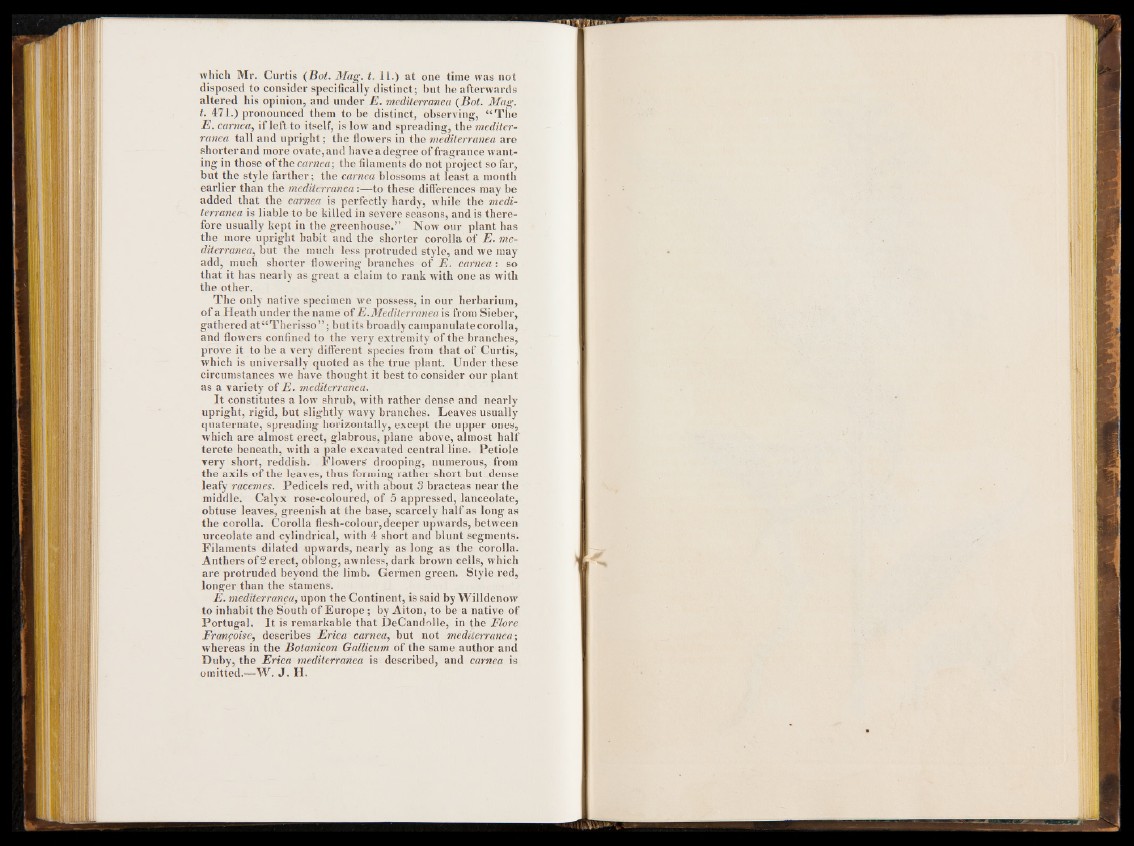
which Mr. Curtis (Bot. Mag. t. li.) at one time was not
disposed to consider specifically distinct; but he afterwards
altered his opinion, and under E. mediterranea (Bot. Mag.
t. 471.) pronounced them to be distinct, observing, “ The
E. cornea, if left to itself, is low and spreading, the mediterranea
tall and upright ; the flowers in the mediterranea are
shorter and more ovate, and have a degree of fragrance wanting
in those of the carnea; the filaments do not project so far,
but the style farther ; the carnea blossoms at least a month
earlier than the mediterranea :—to these differences may be
added that the carnea is perfectly hardy, while the mediterranea
is liable to be killed in severe seasons, and is therefore
usually kept in the greenhouse.” Now our plant has
the more upright habit and the shorter corolla of E. mediterranea,
but the much less protruded style, and we may
add, much shorter flowering branches of E. carnea : so
that it has nearly as great a claim to rank with one as with
the other.
The only native specimen we possess, in our herbarium,
of a Heath under the name of E.Mediterranea is from Sieber,
gathered a t“ Therisso” ; but its broadly campanulate corolla,
and flowers confined to the very extremity of the branches,
prove it to be a very different species from that of Curtis,
which is universally quoted as the true plant. Under these
circumstances we have thought it best to consider our plant
as a variety of E. mediterranea.
It constitutes a low shrub, with rather dense and nearly
upright, rigid, but slightly wavy branches. Leaves usually
quaternate, spreading horizontally, except the upper ones,
which are almost erect, glabrous, plane above, almost half
terete beneath, with a pale excavated central line. Petiole
very short, reddish. Flowers' drooping, numerous, from
the axils of the leaves, thus forming rather short but dense
leafy racemes. Pedicels red, with about 3 bracteas near the
middle. Calyx rose-coloured, of 5 appressed, lanceolate,
obtuse leaves, greenish at the base, scarcely half as long as
the corolla. Corolla flesh-colour, deeper upwards, between
urceolate and cylindrical, with 4 short and blunt segments.
Filaments dilated upwards, nearly as long as the corolla.
Anthers of 2 erect, oblong, awnless, dark brown cells, which
are protruded beyond the limb. Germen green. Style red,
longer than the stamens.
E. mediterranea, upon the Continent, is said by Willdenow
to inhabit the South of Europe ; by Aiton, to be a native of
Portugal. It is remarkable that DeCandolle, in the Flore
Françoise, describes Erica carnea, but not mediterranea-,
whereas in the Botanicon Gallicum of the same author and
Duby, the Erica mediterranea is described, and carnea is
omitted.—W. J . H.